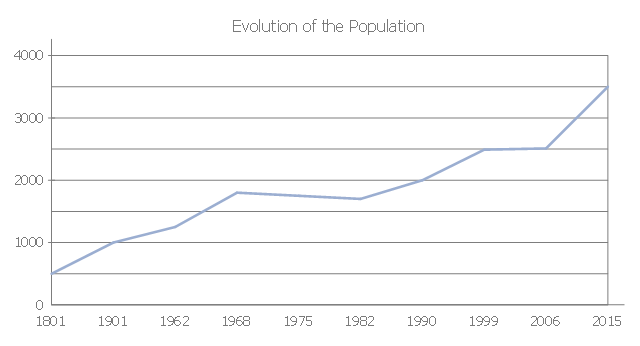This line graph sample shows evolution of the population from 1801 till nowadays. It was designed on the base of the Wikimedia Commons file:
Evolution de la population vertoise 1801 maintenant.JPG
[commons.wikimedia.org/ wiki/ File:Evolution_ de_ la_ population_ vertoise_ 1801_ maintenant.JPG].
"Evolution is the change in the inherited characteristics of biological populations over successive generations. Evolutionary processes give rise to diversity at every level of biological organisation, including species, individual organisms and molecules such as DNA and proteins.
All life on Earth is descended from a last universal ancestor that lived approximately 3.8 billion years ago. Repeated speciation and the divergence of life can be inferred from shared sets of biochemical and morphological traits, or by shared DNA sequences. These homologous traits and sequences are more similar among species that share a more recent common ancestor, and can be used to reconstruct evolutionary histories, using both existing species and the fossil record. Existing patterns of biodiversity have been shaped both by speciation and by extinction." [Evolution. Wikipedia]
The line chart example "Evolution of the population" was created using the ConceptDraw PRO diagramming and vector drawing software extended with the Basic Line Graphs solution from the Graphs and Charts area of ConceptDraw Solution Park.
Evolution de la population vertoise 1801 maintenant.JPG
[commons.wikimedia.org/ wiki/ File:Evolution_ de_ la_ population_ vertoise_ 1801_ maintenant.JPG].
"Evolution is the change in the inherited characteristics of biological populations over successive generations. Evolutionary processes give rise to diversity at every level of biological organisation, including species, individual organisms and molecules such as DNA and proteins.
All life on Earth is descended from a last universal ancestor that lived approximately 3.8 billion years ago. Repeated speciation and the divergence of life can be inferred from shared sets of biochemical and morphological traits, or by shared DNA sequences. These homologous traits and sequences are more similar among species that share a more recent common ancestor, and can be used to reconstruct evolutionary histories, using both existing species and the fossil record. Existing patterns of biodiversity have been shaped both by speciation and by extinction." [Evolution. Wikipedia]
The line chart example "Evolution of the population" was created using the ConceptDraw PRO diagramming and vector drawing software extended with the Basic Line Graphs solution from the Graphs and Charts area of ConceptDraw Solution Park.
- Examples Of Divergence Line Graph
- How To Draw A Divergence Bar Graph
- Concept Of How To Draw Divergent Line Graph
- | How To Construct A Divergent Line Graph
- What Is Divergent Line Graph
- Divergent Line Graph Example
- How To Construct A Divergent Bar Graph
- Evolution of the population | Divergence Line Graph
- How To Draw Divergence Graph
- Examples Of Divergent Line Graph
- Example Of Divergence Line Graph
- How Divergent Bar Graphs Drawn
- Divergent Bar Graphs
- Procedure To Constract Divegent Bar Graph
- | How To Plot The Divergence Bar Graph
- To Solve Divergent Bar Graph
- Diagram Of Divergent Bar Graph
- Line Chart Examples | Line Graph | What Is a Line Chart | Evolution
- Line Chart Examples | Line Graphs | How to Draw a Line Graph ...
- Pie Graph | Ghaph
